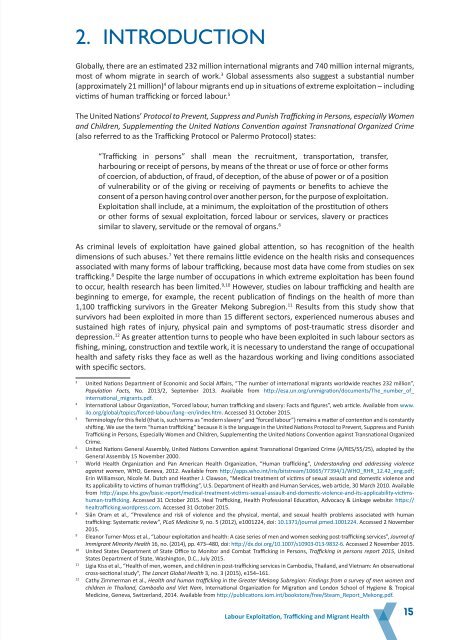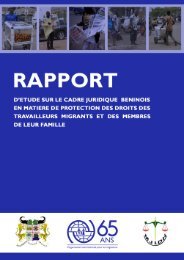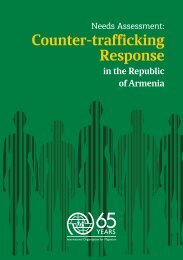Labour Exploitation Trafficking and Migrant Health
labour_exploitation_trafficking_en_0
labour_exploitation_trafficking_en_0
You also want an ePaper? Increase the reach of your titles
YUMPU automatically turns print PDFs into web optimized ePapers that Google loves.
2. Introduction<br />
Globally, there are an estimated 232 million international migrants <strong>and</strong> 740 million internal migrants,<br />
most of whom migrate in search of work. 3 Global assessments also suggest a substantial number<br />
(approximately 21 million) 4 of labour migrants end up in situations of extreme exploitation – including<br />
victims of human trafficking or forced labour. 5<br />
The United Nations’ Protocol to Prevent, Suppress <strong>and</strong> Punish <strong>Trafficking</strong> in Persons, especially Women<br />
<strong>and</strong> Children, Supplementing the United Nations Convention against Transnational Organized Crime<br />
(also referred to as the <strong>Trafficking</strong> Protocol or Palermo Protocol) states:<br />
“<strong>Trafficking</strong> in persons” shall mean the recruitment, transportation, transfer,<br />
harbouring or receipt of persons, by means of the threat or use of force or other forms<br />
of coercion, of abduction, of fraud, of deception, of the abuse of power or of a position<br />
of vulnerability or of the giving or receiving of payments or benefits to achieve the<br />
consent of a person having control over another person, for the purpose of exploitation.<br />
<strong>Exploitation</strong> shall include, at a minimum, the exploitation of the prostitution of others<br />
or other forms of sexual exploitation, forced labour or services, slavery or practices<br />
similar to slavery, servitude or the removal of organs. 6<br />
As criminal levels of exploitation have gained global attention, so has recognition of the health<br />
dimensions of such abuses. 7 Yet there remains little evidence on the health risks <strong>and</strong> consequences<br />
associated with many forms of labour trafficking, because most data have come from studies on sex<br />
trafficking. 8 Despite the large number of occupations in which extreme exploitation has been found<br />
to occur, health research has been limited. 9,10 However, studies on labour trafficking <strong>and</strong> health are<br />
beginning to emerge, for example, the recent publication of findings on the health of more than<br />
1,100 trafficking survivors in the Greater Mekong Subregion. 11 Results from this study show that<br />
survivors had been exploited in more than 15 different sectors, experienced numerous abuses <strong>and</strong><br />
sustained high rates of injury, physical pain <strong>and</strong> symptoms of post-traumatic stress disorder <strong>and</strong><br />
depression. 12 As greater attention turns to people who have been exploited in such labour sectors as<br />
fishing, mining, construction <strong>and</strong> textile work, it is necessary to underst<strong>and</strong> the range of occupational<br />
health <strong>and</strong> safety risks they face as well as the hazardous working <strong>and</strong> living conditions associated<br />
with specific sectors.<br />
3<br />
United Nations Department of Economic <strong>and</strong> Social Affairs, “The number of international migrants worldwide reaches 232 million”,<br />
Population Facts, No. 2013/2, September 2013. Available from http://esa.un.org/unmigration/documents/The_number_of_<br />
international_migrants.pdf.<br />
4<br />
International <strong>Labour</strong> Organization, “Forced labour, human trafficking <strong>and</strong> slavery: Facts <strong>and</strong> figures”, web article. Available from www.<br />
ilo.org/global/topics/forced-labour/lang--en/index.htm. Accessed 31 October 2015.<br />
5<br />
Terminology for this field (that is, such terms as “modern slavery” <strong>and</strong> “forced labour”) remains a matter of contention <strong>and</strong> is constantly<br />
shifting. We use the term “human trafficking” because it is the language in the United Nations Protocol to Prevent, Suppress <strong>and</strong> Punish<br />
<strong>Trafficking</strong> in Persons, Especially Women <strong>and</strong> Children, Supplementing the United Nations Convention against Transnational Organized<br />
Crime.<br />
6<br />
United Nations General Assembly, United Nations Convention against Transnational Organized Crime (A/RES/55/25), adopted by the<br />
General Assembly 15 November 2000.<br />
7<br />
World <strong>Health</strong> Organization <strong>and</strong> Pan American <strong>Health</strong> Organization, “Human trafficking”, Underst<strong>and</strong>ing <strong>and</strong> addressing violence<br />
against women, WHO, Geneva, 2012. Available from http://apps.who.int/iris/bitstream/10665/77394/1/WHO_RHR_12.42_eng.pdf;<br />
Erin Williamson, Nicole M. Dutch <strong>and</strong> Heather J. Clawson, “Medical treatment of victims of sexual assault <strong>and</strong> domestic violence <strong>and</strong><br />
Its applicability to victims of human trafficking”, U.S. Department of <strong>Health</strong> <strong>and</strong> Human Services, web article, 30 March 2010. Available<br />
from http://aspe.hhs.gov/basic-report/medical-treatment-victims-sexual-assault-<strong>and</strong>-domestic-violence-<strong>and</strong>-its-applicability-victimshuman-trafficking.<br />
Accessed 31 October 2015. Heal <strong>Trafficking</strong>, <strong>Health</strong> Professional Education, Advocacy & Linkage website: https://<br />
healtrafficking.wordpress.com. Accessed 31 October 2015.<br />
8<br />
Siân Oram et al., “Prevalence <strong>and</strong> risk of violence <strong>and</strong> the physical, mental, <strong>and</strong> sexual health problems associated with human<br />
trafficking: Systematic review”, PLoS Medicine 9, no. 5 (2012), e1001224, doi: 10.1371/journal.pmed.1001224. Accessed 2 November<br />
2015.<br />
9<br />
Eleanor Turner-Moss et al., “<strong>Labour</strong> exploitation <strong>and</strong> health: A case series of men <strong>and</strong> women seeking post-trafficking services”, Journal of<br />
Immigrant Minority <strong>Health</strong> 16, no. (2014), pp. 473–480, doi: http://dx.doi.org/10.1007/s10903-013-9832-6. Accessed 2 November 2015.<br />
10<br />
United States Department of State Office to Monitor <strong>and</strong> Combat <strong>Trafficking</strong> in Persons, <strong>Trafficking</strong> in persons report 2015, United<br />
States Department of State, Washington, D.C., July 2015.<br />
11<br />
Ligia Kiss et al., “<strong>Health</strong> of men, women, <strong>and</strong> children in post-trafficking services in Cambodia, Thail<strong>and</strong>, <strong>and</strong> Vietnam: An observational<br />
cross-sectional study”, The Lancet Global <strong>Health</strong> 3, no. 3 (2015), e154–161.<br />
12<br />
Cathy Zimmerman et al., <strong>Health</strong> <strong>and</strong> human trafficking in the Greater Mekong Subregion: Findings from a survey of men women <strong>and</strong><br />
children in Thail<strong>and</strong>, Cambodia <strong>and</strong> Viet Nam, International Organization for Migration <strong>and</strong> London School of Hygiene & Tropical<br />
Medicine, Geneva, Switzerl<strong>and</strong>, 2014. Available from http://publications.iom.int/bookstore/free/Steam_Report_Mekong.pdf.<br />
<strong>Labour</strong> <strong>Exploitation</strong>, <strong>Trafficking</strong> <strong>and</strong> <strong>Migrant</strong> <strong>Health</strong><br />
15





